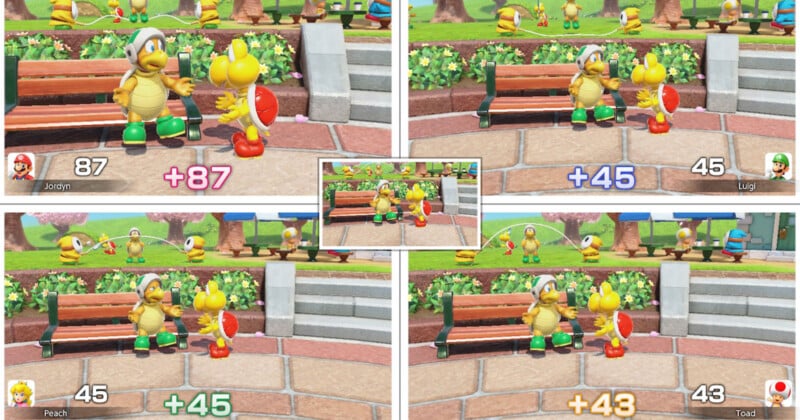Photographers Could Learn a Thing or Two From the New ‘Mario Party’ Game
![]()
Super Mario Party Jamboree for Nintendo Switch features a fun yet challenging minigame about capturing precise street photography moments.
Released late last month on Nintendo Switch, Super Mario Party Jamboree is the latest in the long-running series of board game-style party games featuring the world-famous plumber and his colorful cast of friends. And honestly, it’s so much fun. It doesn’t matter how young or old, there’s something for everyone in this lovable ball of minigame-filled chaos.
![]()
One minigame in particular caught my eye during my very first playthrough. Dubbed “Camera Ready,” the game places the characters in a busy park filled with dozens of Mushroom Kingdom denizens, and each is armed with a camera, which challenges players to recreate specific snapshots. At first glance, it’s a cute imitation of photography action in video games not unlike Pokemon Snap. However, after reflecting a bit (i.e., playing the game nonstop for hours), it’s clear that some critical street photography lessons are being taught here.
Patience Is a Virtue
![]()
As in any street photography situation, the key to the game is patience. At the start of each round, players are presented with the photo they need to recreate but are given no additional context. With only the ability to see the park through the viewfinder, players have to locate where the scene is taking place and often wait for the subjects to match their positions in the reference image.
Players are given a full 360 degrees of motion to pivot from their stationary location, and it’s immediately overwhelming with the amount of activity taking place. In the immediate foreground are various characters on multiple park benches reading a newspaper or talking. However, players also have a zoom lens (albeit an impossible one, something like a 24-1,000mm f/11), and action occurs along many different focal planes. In the midground are food street cart vendors, characters playing with a ball or jumping rope, characters jogging around, and several picnic blankets. And further in the background are various other scenes — too many to name here.

So not only do players have to locate who they’re supposed to photograph, they have to wait for the specific moment to take their shot. Within the 30-second window for each round, the exact frame players need to replicate only happens once or twice, given all the moving elements in the foreground and background. The situation is not unlike standing in the middle of Washington Square Park in the summer and needing to pick out a single individual in the crowd. It’s a photography “Where’s Waldo.”
But the patience on display here is something that all street photographers need in their arsenal. Not only is it enough to find an interesting frame, but it’s the subject of that frame and the motion or energy they person brings to the frame which gives a photograph its life. Often, that requires waiting for the right moment to push the shutter. And no, we don’t have a high burst rate — in this scenario, we’re shooting in a single shot.
Depth and Composition
![]()
While the action in the frame is constantly moving and out of the players’ control, the core gameplay element is using the camera’s zoom lens. But it’s not just enough to get close to matching the focal length of the reference image. After playing a lot, it’s clear that a good amount of the judging criteria emphasizes composition. Is that pink tree in or out of frame? Are the foreground and background elements at the proper size and compression compared to the image subject? The game does take some heavy creative liberties with the focal length characteristics of the zoom lens we’re using, but still, it does a not-half-bad job replicating the parallax one would see through a viewfinder.
![]()
When photographers are walking around with an all-purpose zoom, there’s an instinct to live on both extremes of the lens. I find myself doing this all the time with my trusty 24-70mm f/2.8. However, the beauty of a zoom lens is that there aren’t hard stops at fixed focal lengths. A zoom allows a shot to be taken at 67mm or 44mm — it’s a trombone, not a trumpet.

And that’s what this game forces players to think about. The mission is not to get as close to our subject as we can and throw out the background like on a 135mm f/2 or a 400mm f/2.8. The game judges our ability to frame the subject within the context of their world, to paint an entire scene with our image. Getting too close to — or worse, as does the current trend of smartphone cameras defaulting to a 28mm equivalent influence many a casual shooter, being too far away from — our subject will cost the player points. So too makes the difference between a street shot that ends up on a print and one that lives and dies in our Instagram story.
Grab a Camera and Go
As a filmmaker, with my comfort zone being able to plan my shots meticulously, I’ve always been a very timid street shooter. However, I still love photography. It’s a great feeling to be out on the streets of New York on a mission to find something interesting. I’ve noticed that the more I go out in public with my camera, the more comfortable I get standing still and waiting for the action to come to me.
And oddly enough, that’s the same lesson I’m learning from Mario and Luigi in video game made for children.